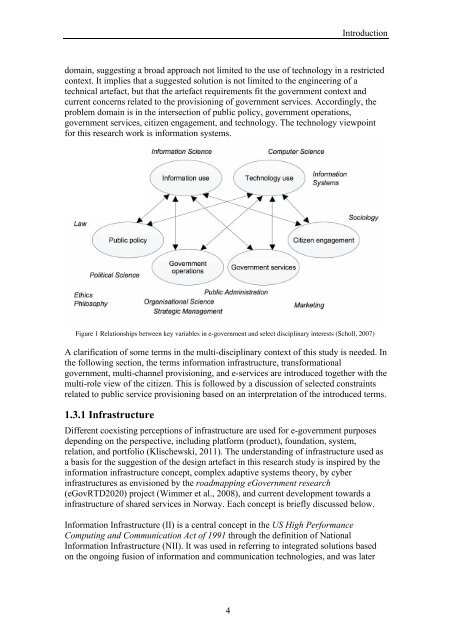Multi-channel provisioning of public services - Department of ...
Multi-channel provisioning of public services - Department of ...
Multi-channel provisioning of public services - Department of ...
Create successful ePaper yourself
Turn your PDF publications into a flip-book with our unique Google optimized e-Paper software.
Introduction<br />
domain, suggesting a broad approach not limited to the use <strong>of</strong> technology in a restricted<br />
context. It implies that a suggested solution is not limited to the engineering <strong>of</strong> a<br />
technical artefact, but that the artefact requirements fit the government context and<br />
current concerns related to the <strong>provisioning</strong> <strong>of</strong> government <strong>services</strong>. Accordingly, the<br />
problem domain is in the intersection <strong>of</strong> <strong>public</strong> policy, government operations,<br />
government <strong>services</strong>, citizen engagement, and technology. The technology viewpoint<br />
for this research work is information systems.<br />
Figure 1 Relationships between key variables in e-government and select disciplinary interests (Scholl, 2007)<br />
A clarification <strong>of</strong> some terms in the multi-disciplinary context <strong>of</strong> this study is needed. In<br />
the following section, the terms information infrastructure, transformational<br />
government, multi-<strong>channel</strong> <strong>provisioning</strong>, and e-<strong>services</strong> are introduced together with the<br />
multi-role view <strong>of</strong> the citizen. This is followed by a discussion <strong>of</strong> selected constraints<br />
related to <strong>public</strong> service <strong>provisioning</strong> based on an interpretation <strong>of</strong> the introduced terms.<br />
1.3.1 Infrastructure<br />
Different coexisting perceptions <strong>of</strong> infrastructure are used for e-government purposes<br />
depending on the perspective, including platform (product), foundation, system,<br />
relation, and portfolio (Klischewski, 2011). The understanding <strong>of</strong> infrastructure used as<br />
a basis for the suggestion <strong>of</strong> the design artefact in this research study is inspired by the<br />
information infrastructure concept, complex adaptive systems theory, by cyber<br />
infrastructures as envisioned by the roadmapping eGovernment research<br />
(eGovRTD2020) project (Wimmer et al., 2008), and current development towards a<br />
infrastructure <strong>of</strong> shared <strong>services</strong> in Norway. Each concept is briefly discussed below.<br />
Information Infrastructure (II) is a central concept in the US High Performance<br />
Computing and Communication Act <strong>of</strong> 1991 through the definition <strong>of</strong> National<br />
Information Infrastructure (NII). It was used in referring to integrated solutions based<br />
on the ongoing fusion <strong>of</strong> information and communication technologies, and was later<br />
4
















